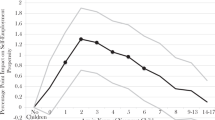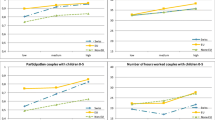Abstract
Explanations for the increase of employment for American mothers with young children have focused on women’s motivations and skills or on increased wages. Instead, this analysis considers how access to professional and managerial occupations may explain this employment trend. Relying on Current Population Survey data (1968–1995), the study reports that growing availability of these occupations explains less than 1/4 of employment growth. The percentage of full-time employed newer mothers in professional and managerial occupations, while having grown substantially over time, remains relatively small. Part-time employment does not explain the trend. Relatively high rates of full-time work, even for low-prestige occupations, affirm existing research emphasizing family economic need and validate questions about the structure of work for accommodating family obligations.
Similar content being viewed by others
References
C. Barnett C. Rivers (1996) She works, he works: How two income families are happier, healthier and better off HarperCollins San Francisco
B. R. Bergmann (1986) The economic emergence of women Basic Books New York
W. G. Bowen T. A. Finegan (1969) The economics of labor force participation Princeton University Press Princeton
M. J. Budig P. England (2001) ArticleTitleThe wage penalty for motherhood American Sociological Review 66 204–225
InstitutionalAuthorNameBureau of Labor Statistics (1988) Labor force statistics derived from the current population survey, 1948–87. U.S. Government Printing Office Washington, DC
Bureau of Labor Statistics. (2000). Employment characteristics of families in 1999. Retrieved May 16, 2001, from ftp://146.142.4.23/pub/news.release/History/famee.06152000.news
P. Burstein (1985) Discrimination, jobs, and politics: The struggle for equal employment opportunity in the United States since the new deal University of Chicago Press Chicago
A. Cherlin (1980) ArticleTitlePostponing marriage: The influence of young women’s work expectations Journal of Marriage and Family 42 355–365
D. A. Cotter J. DeFiore J. M. Hermsen B. M. Kowalewski R. Vanneman (1998) ArticleTitleThe demand for female labor American Journal of Sociology 103 1673–1712 Occurrence Handle10.1086/231404
D. A. Cotter J. M. Hermsen R. Vanneman (2001) ArticleTitleWomen’s work and working women: The demand for female labor Gender & Society 15 429–452
S. Desai L. J. Waite (1991) ArticleTitleWomen’s employment during pregnancy and after the first birth: Occupational characteristics and work commitment American Sociological Review 56 551–566
M. E. Edwards (1996) ArticleTitlePregnancy discrimination litigation: Legal erosion of capitalist ideology under equal employment opportunity law Social Forces 75 247–269
M. E. Edwards (2001a) ArticleTitleHome ownership, affordability, and mothers’ changing work and family roles Social Science Quarterly 82 370–384
M. E. Edwards (2001b) ArticleTitleUncertainty and the rise of the work/family dilemma Journal of Marriage and the Family 63 183–196 Occurrence Handle10.1111/j.1741-3737.2001.00183.x
M. E. Edwards (2002) ArticleTitleEducation and occupation: Re-examining the conventional wisdom about later first births among American mothers Sociological Forum 17 423–443 Occurrence Handle10.1023/A:1019679023616
D. J. Eggebeen A. J. Hawkins (1990) ArticleTitleEconomic need and wives’ employment Journal of Family Issues 11 48–66
M. Elliot (2003) ArticleTitleWork and family role strain among university employees Journal of Family and Economic Issues 24 157–181 Occurrence Handle10.1023/A:1023614907886
P. England (1982) ArticleTitleThe failure of human capital theory to explain occupational sex segregation Journal of Human Resources 17 358–370
J. S. Falzone (2000) ArticleTitleLabor market decisions of married women: With emphasis on part-time employment International Advances in Economic Research 6 662–671
Families and Work Institute. (1997). National study of the changing workforce: Executive summary. Retrieved August 12, 2002, from http://www.familiesandwork.org/nationalstudy.html
R. B. Freeman L. F. Katz (1994) Rising wage inequality: The United States vs. other advanced countries R. B. Freeman (Eds) Working under different rules Russell Sage Foundation New York
B. Garson (1988) The electronic sweatshop Penguin Books New York
A. Gini (2000) My job, my self: Work and the creation of the Modern individual Routledge New York
J. Glass (1988) ArticleTitleJob quits and job changes: The effects of young women’s work conditions and family factors Gender & Society 2 228–240
J. Glass V. Camarigg (1992) ArticleTitleGender, parenthood, and job-family compatability American Journal of Sociology 98 131–151 Occurrence Handle10.1086/229971
C. Goldin (1990) Understanding the gender gap Oxford University Press New York
H. A. Hunt T. L. Hunt (1986) Recent trends in clerical employment: The impact of technological change H. I. Hartmann R. E. Kraut L. A. Tilly (Eds) Computer chips and paper clips: Technology and women’s employment National Academy Press Washington, DC
S. Lebergott (1996) Consumer expenditures: New measures and old motives Princeton University Press Princeton
A. Leibowitz J. A. Klerman (1995) ArticleTitleExplaining changes in married mothers’ employment over time Demography 32 365–378
A. R. Levinson (1996) ArticleTitleRecent trends in part-time employment Contemporary Economic Policy 14 78–89
F. Levy (1987) Dollars and dreams: The changing American income distribution Russell Sage Foundation New York
S. McRae (1993) ArticleTitleReturning to work after childbirth: Opportunities and inequalities European Sociological Review 9 125–137
D. Myers (1985) ArticleTitleWives’ earnings and rising costs of home ownership Social Science Quarterly 66 319–329
V. K. Oppenheimer (1970) The female labor force in the United States University of California Press Berkeley
S. Polacheck (1981) ArticleTitleOccupational self-selection: A human capital approach to sex differences in occupational structure Review of Economics and Statistics 63 60–69
B. F. Reskin P. A. Roos (1990) Job queues, gender queues: Explaining women’s inroads into male occupations Temple University Press Philadelphia
R. R. Rindfuss K. L. Brewster A. L. Kavee (1996) ArticleTitleWomen, work, and children: Behavioral and attitudinal change in the United States Population and Development Review 22 457–482
R. R. Rindfuss S. P. Morgan G. Swicegood (1988) First births in America: Changes in the timing of parenthood University of California Press Berkeley
J. Schor (1999) The overspent American: Why we want what we don’t need HarperCollins New York
D. L. Sharpe J. M. Hermsen J. Billings (2002) ArticleTitleFactors associated with having flextime: A focus on married workers Journal of Family and Economic Issues 23 51–72 Occurrence Handle10.1023/A:1014277630200
J. P. Smith M. P. Ward (1985) ArticleTitleTime-series growth in the female labor force Journal of Labor Economics 3 S59–S90 Occurrence Handle10.1086/298076
J. Waldfogel (1997) ArticleTitleThe effects of children on women’s wages American Sociological Review 62 209–217
Author information
Authors and Affiliations
Corresponding author
Additional information
The author thanks Paul Burstein, Charles Hirschman, Sharon Reitman, and the anonymous reviewers of JFEI for their helpful comments. An earlier version of this paper was presented at the annual meetings of the American Sociological Association in Washington, DC, August 2000.
Rights and permissions
About this article
Cite this article
Edwards, M.E. Occupational Structure and the Employment of American Mothers of Young Children. J Fam Econ Iss 26, 31–53 (2005). https://doi.org/10.1007/s10834-004-1411-5
Issue Date:
DOI: https://doi.org/10.1007/s10834-004-1411-5




